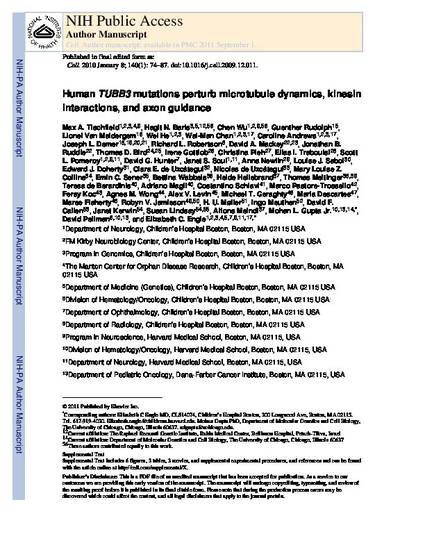
Article
Human TUBB3 mutations perturb microtubule dynamics, kinesin interactions, and axon guidance
Cell
(2010)
Abstract
We report that eight heterozygous missense mutations in TUBB3, encoding the neuron-specific β-
tubulin isotype III, result in a spectrum of human nervous system disorders we now call the
TUBB3 syndromes. Each mutation causes the ocular motility disorder CFEOM3, whereas some
also result in intellectual and behavioral impairments, facial paralysis, and/or later-onset axonal
sensorimotor polyneuropathy. Neuroimaging reveals a spectrum of abnormalities including
hypoplasia of oculomotor nerves, and dysgenesis of the corpus callosum, anterior commissure,
and corticospinal tracts. A knock-in disease mouse model reveals axon guidance defects without
evidence of cortical cell migration abnormalities. We show the disease-associated mutations can
impair tubulin heterodimer formation in vitro, although folded mutant heterodimers can still
polymerize into microtubules. Modeling each mutation in yeast tubulin demonstrates that all alter
dynamic instability whereas a subset disrupts the interaction of microtubules with kinesin motors.
These findings demonstrate normal TUBB3 is required for axon guidance and maintenance in
mammals.
Disciplines
Publication Date
January 8, 2010
DOI
10.1016/j.cell.2009.12.011
Publisher Statement
Copyright 2010 Elsevier Inc.
Citation Information
Max A. Tischfield, Mohan L. Gupta and et al. "Human TUBB3 mutations perturb microtubule dynamics, kinesin interactions, and axon guidance" Cell Vol. 140 Iss. 1 (2010) p. 74 - 87 Available at: http://works.bepress.com/mohan-gupta/9/
